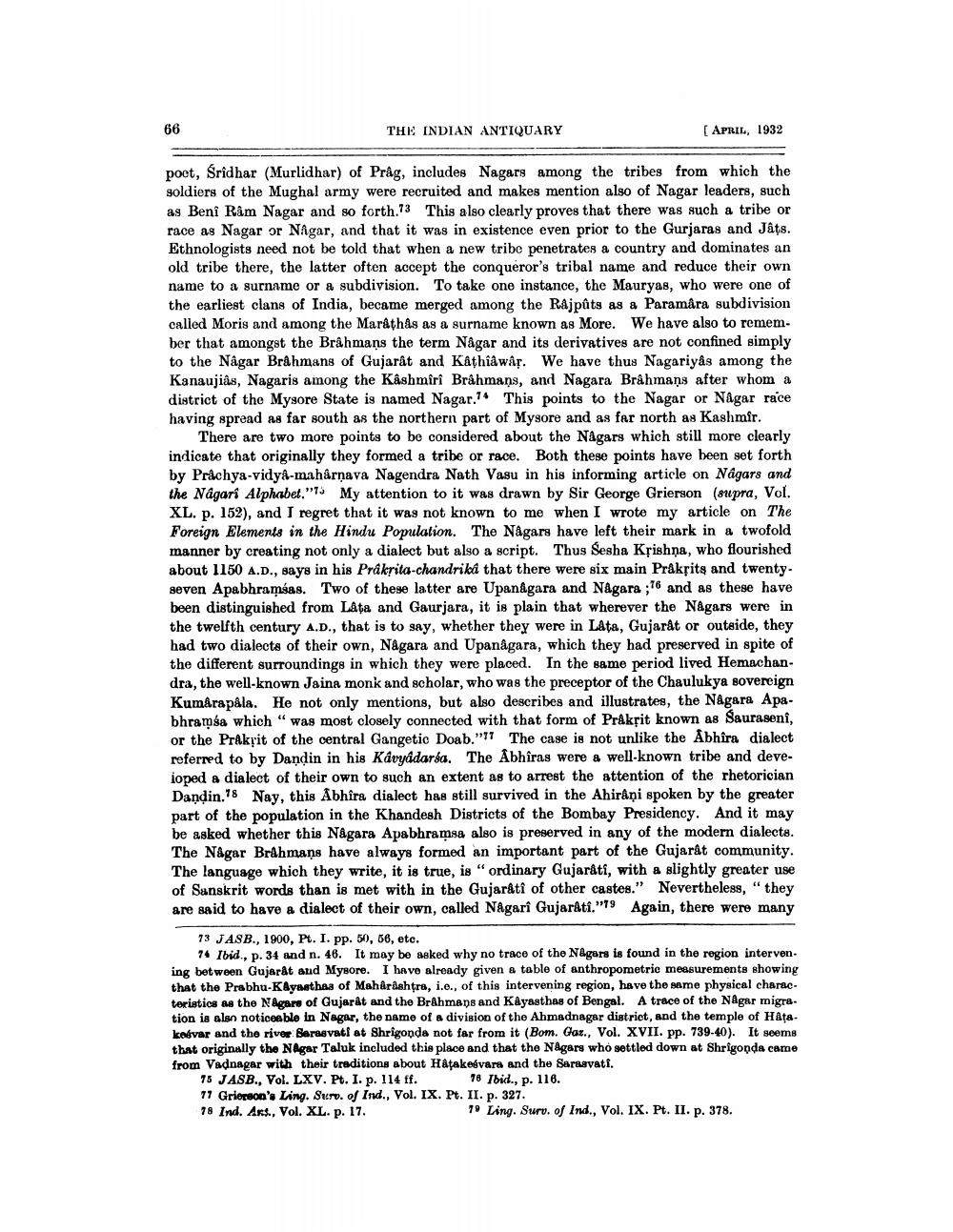________________
66
THE INDIAN ANTIQUARY
[ APRIL, 1932
poct, Sridhar (Murlidhar) of Prag, includes Nagars among the tribes from which the soldiers of the Mughal army were recruited and makes mention also of Nagar leaders, such as Beni Ram Nagar and so forth.73 This also clearly proves that there was such a tribe or race as Nagar or Nagar, and that it was in existence even prior to the Gurjaras and Jåts. Ethnologists need not be told that when a new tribe penetrates a country and dominates an old tribe there, the latter often accept the conqueror's tribal name and reduce their own name to a surname or a subdivision. To take one instance, the Mauryas, who were one of the earliest clans of India, became merged among the Rajpûts as a Paramâra subdivision called Moris and among the Marathås as a surname known as More. We have also to remember that amongst the Brahmans the term Någar and its derivatives are not confined simply to the Nagar Brahmans of Gujarat and Kathîâwâr. We have thus Nagariyås among the Kanaujiâs, Nagaris among the Kashmiri Brahmans, and Nagara Brahmans after whom a district of the Mysore State is named Nagar.?* This points to the Nagar or Någar race having spread as far south as the northern part of Mysore and as far north as Kashmir.
There are two more points to be considered about the Nagars which still more clearly indicate that originally they formed a tribe or race. Both these points have been set forth by Prachya-vidya-mahârnava Nagendra Nath Vasu in his informing article on Nagars and the Nagari Alphabet." My attention to it was drawn by Sir George Grierson (supra, Vol. XL. p. 152), and I regret that it was not known to me when I wrote my article on The Foreign Elements in the Hindu Population. The Någars have left their mark in a twofold manner by creating not only a dialect but also a script. Thus Sesha Krishna, who flourished about 1150 A.D., says in his Prakrita-chandriká that there were six main Prakrits and twentyseven Apabhramsas. Two of these latter are Upanagara and Nagara ;76 and as these have been distinguished from Låta and Gaurjara, it is plain that wherever the Någars were in the twelfth century A.D., that is to say, whether they were in Lata, Gujarat or outside, they had two dialects of their own, Någara and Upanågara, which they had preserved in spite of the different surroundings in which they were placed. In the same period lived Hemachandra, the well-known Jaina monk and scholar, who was the preceptor of the Chaulukya sovereign Kumarapala. He not only mentions, but also describes and illustrates, the Nagara Apabhramsa which was most closely connected with that form of Pråkpit known as Sauraseni, or the Prakrit of the central Gangetic Doab."17 The case is not unlike the Abhira dialect referred to by Dandin in his Kavyadarsa. The Abhîras were a well-known tribe and deveioped a dialect of their own to such an extent as to arrest the attention of the rhetorician Dandin.78 Nay, this Åbhîra dialect has still survived in the Ahirani spoken by the greater part of the population in the Khandesh Districts of the Bombay Presidency. And it may be asked whether this Nagara Apabhramsa also is preserved in any of the modern dialects. The Någar Brahmans have always formed an important part of the Gujarat community. The language which they write, it is true, is "ordinary Gujarati, with a slightly greater use of Sanskrit words than is met with in the Gujarati of other castes." Nevertheless," they are said to have a dialect of their own, called Någari Gujarati."79 Again, there were many
73 JASB., 1900, Pt. I. pp. 50, 56, etc.
74 Ibid., p. 34 and n. 46. It may be asked why no trace of the Nagars is found in the region interven. ing between Gujarat and Mysore. I have already given a table of anthropometric measurements showing that the Prabhu-Kayasthea of Maharashtra, i.e., of this intervening region, have the same physical charac. teristics as the NAgar of Gujarat and the BrAhmans and Kayasthas of Bengal. A trace of the Nagar migra. tion is also noticeable in Nagar, the name of a division of the Ahmadnagar district, and the temple of Hâtakeevar and the river Sarasvati at Shrigonda not far from it (Bom. Gar., Vol. XVII. Pp. 739-40). It seems that originally the Nagar Taluk included this place and that the Nagars who settled down at Shrigonda came from Vadnagar with their traditions about Hatakesvara and the Sarasvati.
75 JASB., Vol. LXV. Pt. I. p. 114 ff. 78 Ibid., p. 116. 11 Grierson's Ling. Suro. of Ind., Vol. IX. Pt. II. p. 327. 78 Ind. Axs., Vol. XL. p. 17.
7° Ling. Suro. of Ind., Vol. IX. Pt. II. p. 378.




